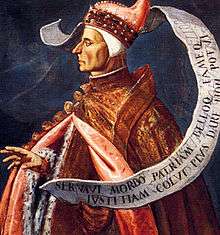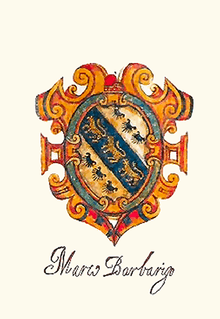Marco Barbarigo
Marco Barbarigo (c. 1413 – August 14, 1486) was the 73rd Doge of Venice from 1485 until 1486.[1][2][3] His nomination took place on a new staircase in the courtyard of the Doge's Palace, on an axis with the Campanile of St. Mark and the Porta della Carta.[4]
Marco Barbarigo | |
|---|---|
 Domenico Robusti, Ritratto del doge Marco Barbarigo. | |
| 73rd Doge of Venice | |
| In office 1485–1486 | |
| Preceded by | Giovanni Mocenigo |
| Succeeded by | Agostino Barbarigo |
| Personal details | |
| Born | 1413 Venice, Republic Of Venice |
| Died | August 14, 1486 (aged 73) Venice, Republic Of Venice |
| Nationality | Italian |
| Spouse(s) | Lucia Ruzzini |
| Father | Francesco Barbarigo |
| Relatives | Agostino Barbarigo |
| Residence | Venice |
| Occupation | Noble |

Barbarigo was elected as Doge of Venice in September 1485 to succeed Doge Giovanni Mocenigo,[1] who was possibly poisoned. Marco died in August 1486,[1] less than a year after becoming Doge, probably in a violent dispute between nobles caused by his brother Agostino.[4][5] He was succeeded as Doge by Agostino Barbarigo, who was Procurator while Marco was Doge,[1] from 1486 until 1501.[2]
Family
His dogaressa was Lucia Ruzzini (d. 1496), described as a hypochondriac but talented beauty.[6] His father was Francesco Barbarigo and his brother was Agostino Barbarigo.[1] He and his brother are the namesakes of the Master of the Barbarigo Reliefs,[7] who was responsible for the creation of their tomb.[8]
Popular culture
- He appears in the video game Assassin's Creed II as a villain, and one of the main character's assassination targets.[9] Barbarigo is depicted as being a puppet of the Knights Templar Grand Master Rodrigo Borgia, and his ally, the fictional Council of Ten member Carlo Grimaldi, who kills Doge Giovanni Mocenigo in order to allow Barbarigo to take over Venice for the Templars.[9] He was killed while holding a speech on a boat during Carnevale by a member of the rival Assassin Order, Ezio Auditore da Firenze, with a hidden gun.[9]
References
- Casola, Pietro; Newett, Mary Margaret (1907). "Notes". Canon Pietro Casola's Pilgrimage to Jerusalem in the Year 1494. Manchester University Press. p. 371.
- Paoletti & Radke 2005, p. 553.
- Operette di Iacopo Morelli bibliotecario di S. Marco ora insieme raccolte con opuscoli di antichi scrittori (in Italian). 1. 1820. p. 102.
- Paoletti & Radke 2005, p. 334, Commemorative State Commissions.
- Sagredo, Agostino. Annals of Malipiero. p. 680.
- Staley 1910, p. 317, Roll of the Most Serene Dogaressas of Venice.
- "Elijah in the Fiery Chariot". The Metropolitan Museum of Art. Retrieved 13 September 2018.
- Munman, Robert (1977). "The Last Work of Antonio Rizzo". Arte Lombarda. Vita e pensiero – Pubblicazioni dell’Università Cattolica del Sacro Cuore (47/48): 89–98. JSTOR 43105107.
- Bowden 2009.
External links
| Wikimedia Commons has media related to Marco Barbarigo. |
Bibliography
- Bowden, Oliver (2009). Assassin's Creed: Renaissance. Penguin Books Limited. p. 528. ISBN 9780141046303.CS1 maint: ref=harv (link)
- Paoletti, John T.; Radke, Gary M. (2005). Art in Renaissance Italy. Laurence King Publishing. p. 576. ISBN 9781856694391.CS1 maint: ref=harv (link)
- Staley, Edgcumbe (1910). University of California Libraries (ed.). The dogaressas of Venice: The wives of the doges. London: T. W. Laurie. p. 430.CS1 maint: ref=harv (link)
| Political offices | ||
|---|---|---|
| Preceded by Giovanni Mocenigo |
Doge of Venice 1485–1486 |
Succeeded by Agostino Barbarigo |